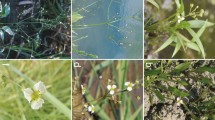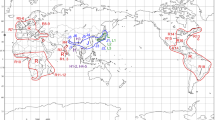Abstract
Recent molecular phylogenetic studies reported high diversity of Ruppia species in the Mediterranean. Multiple taxa, including apparent endemics, are known from that region, however, they have thus far not been exposed to phylogenetic analyses aimed at studying their relationships to taxa from other parts of the world. Here we present a comprehensive phylogenetic analyses of the R. maritima complex using data sets composed of DNA sequences of the plastid genome, the multi-copy nuclear ITS region, and the low-copy nuclear phyB gene with a primary focus on the Mediterranean representatives of the complex. As a result, a new lineage, “Drepanensis”, was identified as the seventh entity of the complex. This lineage is endemic to the Mediterranean. The accessions included in the former “Tetraploid” entity were reclassified into two entities: an Asia–Australia–Europe disjunct “Tetraploid_α” with a paternal “Diploid” origin, and a European “Tetraploid_γ” originating from a maternal “Drepanensis” lineage. Another entity, “Tetraploid_β”, is likely to have been originated as a result of chloroplast capture through backcrossing hybridization between paternal “Tetraploid_α” and maternal “Tetraploid_γ”. Additional discovery of multiple tetraploidizations as well as hybridization and chloroplast capture at the tetraploid level indicated that hybridization has been a significant factor in the diversification of Ruppia.




Similar content being viewed by others
References
Alvarez I, Wendel JF (2003) Ribosomal ITS sequences and plant phylogenetic inference. Mol Phylogenet Evol 29:417–434
Baldwin BG (1992) Phylogenetic utility of the internal transcribed spacers of nuclear ribosomal DNA in plants: an example from the Compositae. Mol Phylogenet Evol 1:3–16
Castroviejo S (1983) Números cromosomáticos de plantas occidentales, 211–222. Anales Jard Bot Madrid 39:525–531 (in Spanish)
Chiang T-Y, Hong K-H, Peng C-I (2001) Experimental hybridization reveals biased inheritance of the internal transcribed spacer of the nuclear ribosomal DNA in Begonia × taipeiensis. J Plant Res 114:343–351
Cirujano S (1982) Aportaciones a la flora de los saladares castellanos. Anales Jard Bot Madrid 39:167–173 (in Spanish)
Cirujano S (1986) El género Ruppia L. (Potamogetonaceae) en la mancha (España). Bol Soc Brot sér. 2, 59: 293–303 (in Spanish)
Clarke LA, Rebelo CS, Gonçalves J, Boavida MG, Jordan P (2001) PCR amplification introduces errors into mononucleotide and dinucleotide repeat sequences. Mol Pathol 54:351–353
Farris JS, Källersjö M, Kluge AG, Bult C (1994) Testing significance of incongruence. Cladistics 10:315–319
Felsenstein J (1985) Confidence limits on phylogenies- an approach using the bootstrap. Evolution 39:783–791
Ito Y, Ohi-Toma T, Murata J, Tanaka N (2010) Hybridization and polyploidy of an aquatic plant, Ruppia (Ruppiaceae), inferred from plastid and nuclear DNA phylogenies. Am J Bot 97:1156–1167
Jacobs SWL, Brock MA (2011) Ruppiaceae. In: Wilson A (ed) Flora of Australia, volume 39, Alismatales to Arales. ABRS/CISRO, Melbourne, pp 95–98
Kelchner SA (2000) The evolution of non-coding chloroplast DNA and its application in plant systematics. Ann Missouri Bot Gard 87:482–498
Kim S-T, Sultan SE, Donoghue MJ (2008) Allopolyploid speciation in Persicaria (Polygonaceae): insights from a low-copy nuclear region. Proc Natl Acad Sci USA 105:12370–12375
Marchioni-Ortu A (1982) Numeri cromosomici per la Flora Italiana: 873–876. Inf Bot Ital 14:234–237 (in Italy)
Marcussen T, Jakobsen KS, Danihelka J, Ballard HE, Blaxland K, Brysting AK, Oxelman B (2012) Inferring species networks from gene trees in high-polyploid North American and Hawaiian violets (Viola, Violaceae). Syst Biol 61:107–126
Mathews S, Tsai RC, Kellogg EA (2000) Phylogenetic structure in the grass family (Poaceae): evidence from the nuclear gene phytochrome B. Am J Bot 87:96–107
Nylander JAA (2002) MrModeltest v.1.0. Program distributed by the author. Department of Systematic Zoology, Uppsala University, Uppsala. http://www.ebc.uu.se/systzoo/staff/nylander.html
Ronquist F, Huelsenbeck JP (2003) MrBayes 3: bayesian phylogenetic inference under mixed models. Bioinformatics 19:1572–1574
Sang T (2002) Utility of low-copy nuclear gene sequences in plant phylogenetics. Crit Rev Biochem Mol 37:121–147
Sang T, Crawford DJ, Stuessy TF (1995) Documentation of reticulate evolution in peonies (Paeonia) using internal transcribed spacer sequences of nuclear ribosomal DNA: implications for biogeography and concerted evolution. Proc Natl Acad Sci USA 92:6813–6817
Sang T, Crawford DJ, Stuessy TF (1997) Chloroplast DNA phylogeny, reticulate evolution, and biogeography of Paeonia (Paeoniaceae). Am J Bot 84:1120–1136
Setchell WA (1946) The genus Ruppia L. Proc Calif Acad Sci 25:469–478
Simmons MP, Ochoterena H (2000) Gaps as characters in sequence-based phylogenetic analyses. Syst Biol 49:369–381
Soltis DE, Mavrodiev EV, Doyle JJ, Rauscher J, Soltis PS (2008) ITS and ETS sequence data and phylogeny reconstruction in allopolyploids and hybrids. Syst Bot 33:7–20
Swofford DL (2002) PAUP*: Phylogenetic analysis using parsimony (*and other methods), version 4.0b. Sinauer, Sunderland, Massachusetts, USA
Talavera S, Garcia-Murillo P, Herrera J (1993) Chromosome numbers and a new model for karyotype evolution in Ruppia L. (Ruppiaceae). Aquat Bot 45:1–13
Triest L, Sierens T (2010) Chloroplast sequences reveal a diversity gradient in the Mediterranean Ruppia cirrhosa species complex. Aquat Bot 93:68–74
Triest L, Sierens T (2013) Is the genetic structure of Mediterranean Ruppia shaped by bird-mediated dispersal or sea currents? Aquat Bot 104:176–184
Triest L, Symoens JJ (1991) Isozymes in populations of the submerged halophyte Ruppia (Ruppiaceae). Op Bot Belg 4:117–134
Van Vierssen W, van Wijk RJ, van der Zee JR (1981) Some additional notes on the cytotaxonomy of Ruppia taxa in western Europe. Aquat Bot 11:297–301
Weiss-Schneeweiss H, Blöch C, Turner B, Villaseñor JL, Stuessy TF, Schneeweiss GM (2012) The promiscuous and the chaste: frequent allopolyploid speciation and its genomic consequences in American daisies (Melampodium sect. Melampodium; Asteraceae). Evolution 66:211–228
Wendel JF, Schnabel A, Seelanan T (1995) Bidirectional interlocus concerted evolution following alloploid speciation in cotton (Gossypium). Proc Natl Acad Sci USA 92:280–284
Yang Z, Rannala B (1997) Bayesian phylogenetic inference using DNA sequences: a Markov Chain Monte Carlo method. Mol Biol Evol 14:717–724
Zhao LC, Wu ZY (2008) A review of the taxonomy and evolution of Ruppia. J Syst Evol 46:467–478
Acknowledgments
The authors thank Dr. P. Garcia-Murillo (Seville, Spain), Dr. S. Sciandrello (Sicily, Italy), Mr. S. Mifsud (Malta), Dr. H. Freitag (Kassel, Germany), Dr. S. R. Yadav (Kolhapur, India), Dr. J. J. Orth (Virginia, USA), Dr. H. J. Cho (Mississippi, USA), and Dr. S. W. L. Jacobs (Sydney, Australia) for their help with field research and Drs. D. Potter (California, USA) and P. B. Pelser (Christchurch, NZ) for revising the draft version of this manuscript.
Author information
Authors and Affiliations
Corresponding author
Appendices
Appendix 1
The 1st data set for Fig. 1. The taxonomic grouping of Triest and Sierens (2013); OTUs; GenBank accessions: psbA–trnH, and ITS; sample origins; Voucher specimens; haplotype of Triest and Sierens (2010); and ITS type of Triest and Sierens (2013). Note that Hybrid Spain has no specific haplotype and ITS accessions in Triest and Sierens (2010, 2013); only haplotype and ITS type are shown. Samples from Triest and Sierens (2010, 2013) are indicated by underlines. DNA accessions obtained in the present study are shown with asterisks.
“ R. maritima ”—R. maritima S. Africa: JN113274, JN113282 + JN113285; S. Africa; LT-RH-20 (BRVU); haplotype d; ITS-a. R. maritima France: JN113269, JN113282 + JN113285; France; LT-R-678 (BRVU); haplotype d; ITS-a. R. maritima Finland: JN113272, JN113282 + JN113285; Finland; LT-R-2540 (BRVU); haplotype d; ITS-a. R. maritima B: AB728718*, AB728734*; Anatom Island, Vanuatu; TNS9516725 (TNS). R. maritima B’: AB728719*, AB728735*; Yuhong, Sanya, Hainan, China; YI00743 (TNS). R. maritima B’’: AB728720*, AB728736*; Maharashtra, India; YI01209 (TNS). R. maritima B’’’: AB728737*, AB728721*; Grand Bay, Gulf of Mexico, Jackson, Mississippi, USA; YI01233 (TNS). R. maritima C: AB728722*, AB728738*; Chesapeake Bay, Maryland, USA; YI00958 (TNS). R. maritima D: AB728723*, AB728739*; Cape Breton Island, Nova Scotia, Canada; CAN521697 (SAP).
“ R. cirrhosa _I”—R. cirrhosa Italy: JN113271, JN113282 + JN113285; Italy; LT-R-1325 (BRVU); haplotype e; ITS-a. R. cirrhosa Spain_I: JN113270, JN113282 + JN113285; Spain; LT-R-199 (BRVU); haplotype e; ITS-a. R. cirrhosa Egypt: JN113273, JN113282 + JN113285; Egypt; LT-RH-18 (BRVU); haplotype e; ITS-a. R. maritima E: AB728725*, AB728741*; Montecollina Bore, c. 218 km NE Lyndhurst, Strzelecki Track, South Australia, Australia; SJ9694 (TI, TNS, NSW). R. maritima E’: AB728726*, AB728742*, AB728743*; Shiokawa River, Okinawa, Japan; YI00754 (TNS). R. maritima H: AB728727*, AB728744*; Canatilla, Huelva, Spain; YI01552 (TNS).
“ R. cirrhosa _II”—R. cirrhosa Greece: JN113267, JN113280 + JN113283; Greece; LT-R-750 (BRVU); haplotype b; ITS-b. R. cirrhosa Spain_II: JN113268, JN113280 + JN113283; Spain; LT-R-2328 (BRVU); haplotype b; ITS-b. R. cirrhosa A: AB728730*, AB728748*, AB728749*; Skye Island, U.K.; YI01299 (TNS). R. maritima F: AB728731*, AB728750*; Dubrovnik, Croatia; YI00878 (TNS). R. maritima K: AB728732*, AB728751*; Vendicari Natural Reserve, Noto, Sicily, Italy; YI01571 (TNS). R. maritima L: AB728733*, AB728752*; Bonba, Huelva, Spain; YI01549 (TNS).
“ R. drepanensis ”—R. drepanensis Spain: JN113266, JN113281 + JN113284; Spain; LT-R-91 (BRVU); haplotype a; ITS-c. R. cirrhosa B: AB728724*, AB728740*; Donana National Park, Sevilla, Spain; YI01567 (TNS).
“cp-capture”—Hybrid Spain: Spain; haplotype b; ITS-a. R. maritima I: AB728728*, AB728745*; Gozo Island, Malta; YI01491 (TNS). R. maritima J: AB728729*, AB728746*, AB728747*; Morgerra Salt Marsh, Marzanemi, Sicily, Italy; YI01575 (TNS).
Appendix 2
The 2nd data set for Fig. 2. The entities of the R. maritima complex; OTUs; GenBank accessions: matK, rbcL, rpoB, rpoC1, and phyB (a = partially obtained sequences); sample origins; Voucher specimens. DNA accessions obtained in the present study are shown with asterisks.
“Diploid”—R. maritima B: AB507905, AB507865, AB507945, AB507985, AB508028; Anatom Island, Vanuatu; TNS9516725 (TNS). R. maritima B’: AB507914, AB507874, AB507954, AB507994, AB508037; Yuhong, Sanya, Hainan, China; YI00743 (TNS). R. maritima B’’: AB507910, AB507870, AB507950, AB507990, AB508033; Maharashtra, India; YI01209 (TNS). R. maritima B’’’: AB507908, AB507868, AB507948, AB507988, AB508031; Grand Bay, Gulf of Mexico, Jackson, Mississippi, USA; YI01233 (TNS). R. maritima C: AB507911, AB507871, AB507951, AB507991, AB508034; Chesapeake Bay, Maryland, USA; YI00958 (TNS). R. maritima D: AB507907, AB507867, AB507947, AB507987, AB508030; Cape Breton Island, Nova Scotia, Canada; CAN521697 (SAP).
“Drepanensis”—R. cirrhosa B: AB728682*, AB728688*, AB728694*, AB728700*, AB728706*, AB728707*; Donana National Park, Sevilla, Spain; YI01567 (TNS).
“Filifolia”—R. maritima G; AB534779, AB534787, AB534793, AB534799, AB534808, AB534809; Port Stephens, West Falkland, Falklands, UK; YI01251 (TNS).
“Occidentalis”—R. polycarpa B: AB507937, AB507897, AB507977, AB508017, AB508073; Redberry Lake, Saskatchewan, Canada; YI01264 (TNS).
“Tetraploid_α”—R. maritima E: AB507919, AB507879, AB507959, AB507999, aAB508046, aAB508047; Montecollina Bore, c. 218 km NE Lyndhurst, Strzelecki Track, South Australia, Australia; SJ9694 (TI, TNS, NSW). R. maritima E’: AB507924, AB507884, AB507964, AB508004, AB508056, AB508057; Shiokawa River, Okinawa, Japan; YI00754 (TNS). R. maritima H: AB728683*, AB728689*, AB728695*, AB728701*, AB728708*, AB728709*; Canatilla, Huelva, Spain; YI01552 (TNS).
“Tetraploid_β”—R. maritima I: AB728684*, AB728690*, AB728696*, AB728702*, AB728710*, AB728711*; Gozo Island, Malta; YI01491 (TNS). R. maritima J: AB728685*, AB728691*, AB728697*, AB728703*, AB728747*, AB728712*, AB728713*; Morgerra Salt Marsh, Marzanemi, Sicily, Italy; YI01575 (TNS).
“Tetraploid_γ”—R. cirrhosa A: AB507925, AB507885, AB507965, AB508005, AB508058, AB508059*; Skye Island, U.K.; YI01299 (TNS). R. maritima F: AB507915, AB507875, AB507955, AB507995, AB508038, AB508039; Dubrovnik, Croatia; YI00878 (TNS). R. maritima K: AB728686*, AB728692*, AB728698*, AB728704*, AB728714*, AB728715*; Vendicari Natural Reserve, Noto, Sicily, Italy; YI01571 (TNS). R. maritima L: AB728687*, AB728693*, AB728699*, AB728705*, AB728716*, AB728717*; Bonba, Huelva, Spain; YI01549 (TNS).
“Utahian”—R. maritima A; AB507928, AB507888, AB507968, AB508008, AB508064; Salt Lake City, Utah, U.S.A.; YI01274 (TNS).
R. polycarpa S. Mason—R. polycarpa A: AB507938, AB507898, AB507978, AB508018, AB508074; Coila Creek, S Moruya, New South Wales, Australia; SJ9719 (NSW).
Rights and permissions
About this article
Cite this article
Ito, Y., Ohi-Toma, T., Murata, J. et al. Comprehensive phylogenetic analyses of the Ruppia maritima complex focusing on taxa from the Mediterranean. J Plant Res 126, 753–762 (2013). https://doi.org/10.1007/s10265-013-0570-6
Received:
Accepted:
Published:
Issue Date:
DOI: https://doi.org/10.1007/s10265-013-0570-6




